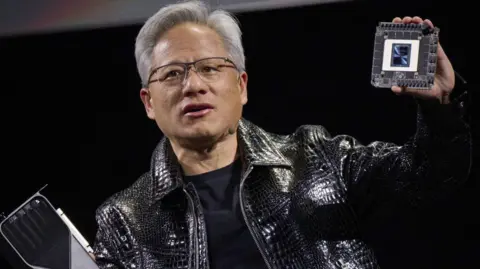Nvidia, the American technology giant renowned for its innovative chip technology, recently made significant headlines at the Consumer Electronics Show (CES) in Las Vegas. Jensen Huang, the co-founder and CEO of the company, showcased the much-anticipated RTX 50-series gaming chips, a breakthrough in gaming graphics. This revealed not just a new product line but also a step forward in the realm of artificial intelligence (AI) and graphics rendering.
During his keynote address, Huang emphasized the capabilities of the new chips, highlighting their use of Nvidia’s cutting-edge Blackwell AI technology. This advancement is purported to generate movie-quality images in real-time, which could redefine graphical benchmarks for gaming and related applications. The RTX 50-series chips will be priced between $549 and $1,999, demonstrating a range that caters to both casual gamers and high-end users. Importantly, these chips promise to deliver performance that is twice as fast as their predecessors, an appealing feature for enthusiasts eager for more immersive gaming experiences.
The excitement surrounding the launch was palpable, and Huang further captivated the audience through a live demonstration that showcased the chips’ exceptional graphical fidelity. Viewers were treated to stunning visuals filled with intricate textures and dynamic movements, a stark contrast to the previously anticipated pre-rendered graphics that had dominated the gaming landscape. Gary Yang, a robotics graduate student from the California Institute of Technology (Caltech), expressed his astonishment at the real-time capabilities showcased, illustrating a shift in expectations regarding gaming graphics.
As the 2025 CES unfolds, Nvidia’s RTX 50-series is set to become available to consumers starting from late January. Tech enthusiasts and industry professionals alike eagerly await what this new technology will bring. Scott Epstein, a representative from the technology startup Agenovate AI, echoed Yang’s sentiment, noting the continual innovation presented by Nvidia. This iterative progression fuels excitement not only among consumers but also within the competitive landscape of technology.
The CES, with its draw of over 150,000 attendees and 4,500 exhibitors, provides a rich backdrop for such announcements. As new technology is consistently unveiled, Nvidia’s noteworthy achievements keep the company at the forefront of industry discussions. Leading up to the CES, Nvidia’s stocks had seen a record high, indicating strong market confidence and anticipation surrounding Huang’s address.
In the first part of his presentation, Huang provided an insightful look into Nvidia’s history, tracing its journey since its founding in 1993. Originally focused on developing graphics chips, primarily for video gaming, Nvidia has successfully transitioned to a leader in AI chip technology, reaching an impressive market valuation exceeding $3 trillion. The evolution of the company mirrors the shifts in technological demands over the decades, emphasizing its ability to adapt and innovate continuously.
Nevertheless, Nvidia’s growth comes with notable challenges. Regulatory scrutiny has intensified as concerns emerge regarding the company’s expanding dominance in the AI chip sector. Huangs’s address took place against this backdrop, as officials from multiple countries, including the USA, UK, EU, South Korea, and China, have expressed concerns about Nvidia’s market influence. The company’s size and impact have prompted investigations by watchdogs analyzing its practices and market power.
In conclusion, Nvidia’s unveiling of the RTX 50-series marks a pivotal moment not just for gaming technology but also for the future of AI in computing. With Jensen Huang’s compelling presentation at CES, the company solidifies its position as a trailblazer in the tech industry, while simultaneously navigating the challenges that accompany its rapid growth and innovation. As the market awaits the release of these new chips, anticipation remains high for how they will transform the gaming experience and computing landscape at large.



